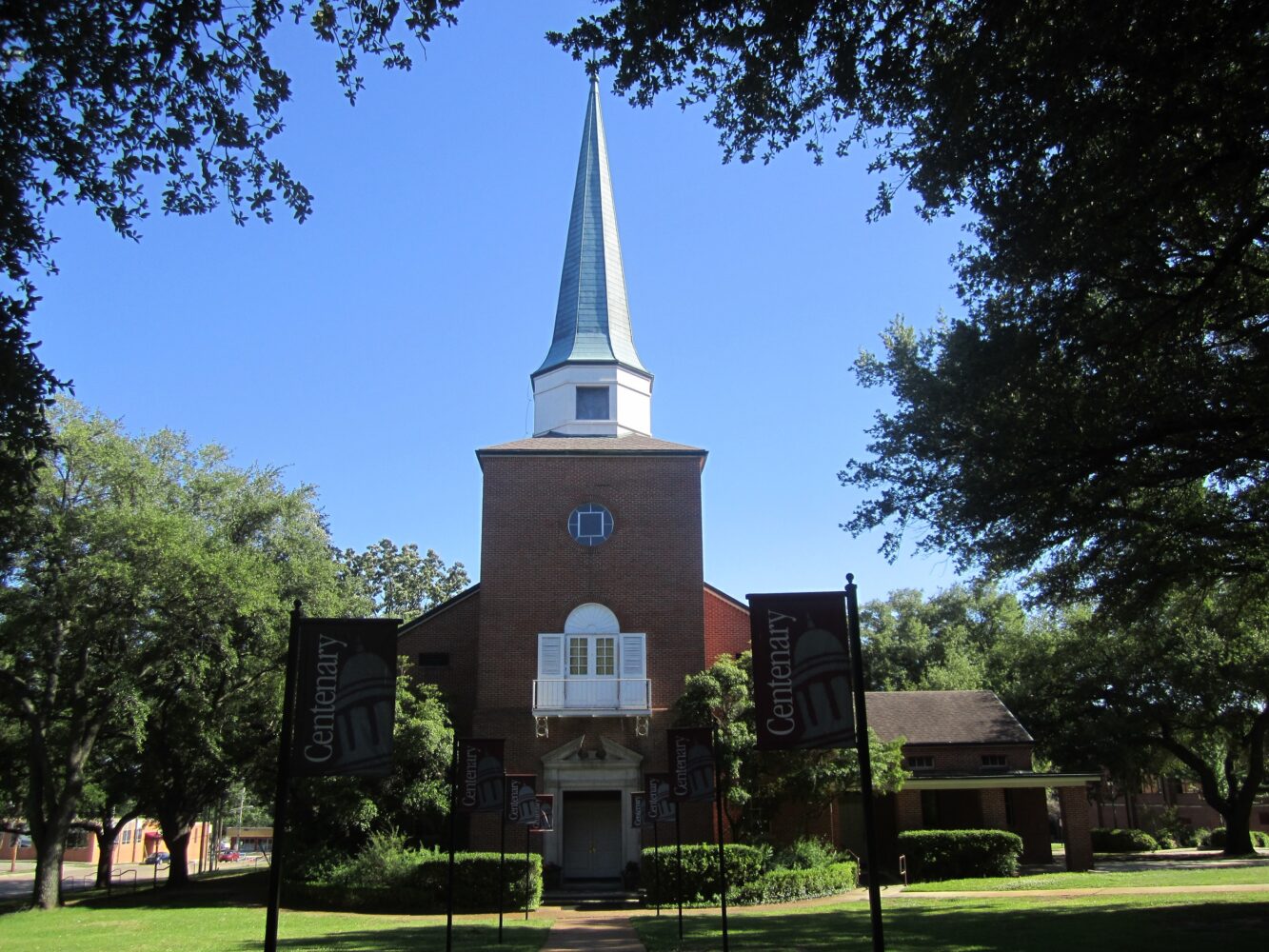Centenary College of Louisiana
Centenary College of Louisiana is an undergraduate liberal arts college in Shreveport and the oldest continuously operated private college in the western half of the United States.

Courtesy of Wikimedia Commons
Chapel, Centenary College of Louisiana. Billy Hathorn
Centenary College of Louisiana is an undergraduate liberal arts college in Shreveport affiliated with the United Methodist Church. Though not the first college established west of the Mississippi River, it is the oldest continuously operated private college in the western half of the United States as well as the forty-third oldest college in the country.
Early History
Situated on 64 acres in the heart of Shreveport, Centenary is the direct descendant of two institutions of higher learning, the oldest dating back to 1825. That year, the Louisiana legislature chartered the College of Louisiana, which was established in the town of Jackson in East Feliciana Parish. The charter established a public college, which remains in effect today with modifications, and it is from this charter that Centenary College of Louisiana claims its initial establishment.
By 1845 the state-supported College of Louisiana was in dire financial straits and was threatened with closure. That year the College of Louisiana was bought by another college, the private Methodist Centenary, which was founded in Brandon, Mississippi, in 1839 and was named for the hundredth anniversary of the organization of the Methodist societies of England, forerunner to the Methodist Church. The renamed Centenary College grew as a private institution in East Feliciana Parish. Shortly after the merger, the college’s administration constructed a large dormitory to match one built in 1833. In 1856 a state-of-the-art academic building was erected between these earlier dorms. This new “Center Building” was, at the time of its construction, the largest building in Louisiana and included a library, numerous classrooms and laboratories as well as a 3,000-seat theater. (Part of the original campus in Jackson is now a museum operated by the Louisiana Department of State Parks and Historic Sites.)
In the mid-nineteenth century, Centenary was considered part of the “Ivy League of the South,” attracting well-to-do sons of planters and statesmen, many of whom would go on to national prominence in politics and business. According to a report by Dr. Lee Morgan prepared for the 175’s anniversary of the school, “tuition was $50 per year. Room, board, and firewood were $7 per month.”
The Civil War and Relocation to Shreveport
Centenary closed its doors for the duration of the Civil War. The school’s faculty minutes of 1861 recorded: “Students all gone to war. College suspended—and God help the right.” The campus was the scene of a battle during the war, and the College was used as a hospital and was captured and recaptured by Union and Confederate forces. Though buildings suffered little damage, they fell into disrepair quickly and were in a state of near ruin by the end of the war. Financially strapped once again, Centenary made a partial recovery, but for years after the war, it was a mere shadow of its former self. Searching for ways to remain open, Centenary began admitting women to the previously all-male college in 1900.
In the early years of the twentieth century another dramatic change took place: the campus moved to its present location in Shreveport. In 1906 Rutherford-Atkins Realty Co. donated forty acres south of Shreveport’s then city limits to Centenary. A streetcar line was put up connecting the site of the new campus to downtown, and in 1908 the first building of Centenary’s new campus was completed—Jackson Hall, named in deference to the original East Feliciana Parish campus. The new unit housed all college operations until others could be built. Classes began on September 8 of that year.
By 1921, however, the new Centenary appeared to be floundering again. Dr. George Sexton, former minister of First Methodist Church in Shreveport, was hired as president that year and oversaw a turnaround. Under Sexton, the building program accelerated, a sizeable endowment and a football team were established, and academic programs expanded. The football team became one of the nation’s most formidable and brought national attention to the college, but it ceased to exist during and after World War II, which depleted the campus of team players. In 1926 Sexton named Centenary’s male varsity sports teams the “Gentlemen” (previously known as the “Ironsides”). Women’s sports teams would later be known as the “Ladies.” Eventually, in 2007, students and alumni voted to make Louisiana’s state dog, the Catahoula, the college’s mascot.
Post-World War II
Following World War II, Centenary experienced dramatic changes that would shape it well into the twenty-first century. In 1945, under the leadership of President J. J. Mickle, the campus experienced a postwar building boom and increased enrollment thanks to the legions of veterans taking advantage of the G.I. Bill. In 1965 the College saw further changes to its student body through the admission of its first African American students, with Mary Celeste Reagan becoming the first African American graduate in 1969.
In 1975, thanks to a gift from oilman alumnus Algur H. Meadows, the campus saw the establishment of the Meadows Museum of Art in the old administration building on Centenary Boulevard. The museum houses a collection of 360 pieces by French artist Jean Despujols, a long-time resident of the city, and frequently shows traveling exhibits.
Despite its growth, diversity, and ambition, the college faced yet another round of financial challenges in the 1970s. The appointment of Dr. Donald A. Webb in 1977 is credited with putting the institution on the right track, ensuring its survival through today.
In the 2019–20 academic year, Centenary, with an undergraduate enrollment of 552 students, was one of sixteen colleges and universities constituting the Associated Colleges of the South (ACS) and was regularly recognized as one of the top colleges in the South. Princeton Review named Centenary one of the “Best 384 Colleges” and one of the “Best Southeastern Colleges” for 2018.
